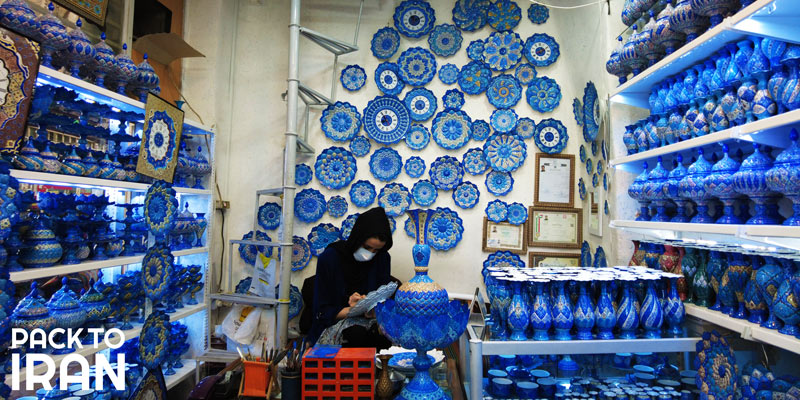Persian Miniature Painting
Persian Miniature painting (Taz-hib), is one of the most famous arts in Iran. It is difficult to trace the origins of the art of the Persian miniature, but it reached its peak mainly during the Mongol and Timurid periods (13th to 16th century). The most important function of miniature painting was illustration. It gave a visual image to the literary stories and poetry books such as Shahnameh (the book of kings) of Ferdowsi. Camel's bone is the main material to do this painting on it and of course, they paint on paper as well. In the olden time, ivory was used for this special kind of painting. Persian miniature is a unique form of art that has been practiced in Iran for centuries. This art form is characterized by its intricate details and vibrant colors, which are used to create stunning depictions of Persian life and culture.
|
|
| Persian miniature |
The Schools of Persian miniature
There were five main schools of miniature in Iran; Herat School, Tabriz School, Shiraz School, Qazvin and from the 17th century, Isfahan School.
The flourishing period of the Persian miniature in Shiraz was the 14th century when the city witnessed a new rise in the development of its cultural life. This was the time of Saadi, Khajoo Kermani, and Hafez. Poetry and literature flourished so did miniature painting. In this period, some well-known artists moved to Shiraz from Samarqand and Heart, therefore, Shiraz school gained much more maturity to the extent that by the end of the 15th Century it was producing miniatures of the highest quality. This school is known for its use of bold colors and strong lines, as well as its emphasis on calligraphy. The paintings from this school often depict poetry and calligraphic compositions.
Tabriz school of art was established at the end of the 13th century and its illustrations tended to combine Far Eastern characters with the Byzantine style of painting. In Tabriz School, there was an emphasis on architecture and landscape and figures were painted livelier and more natural. Tabriz school of miniature is known for Strong design of figures in different situations, colorful covers, elaborate compositions, architectural decorations with geometric and plant motifs, azure sky, clouds and beautiful, detailed birds.
In the 15th century, the miniature school of Herat was established and many of the best artists from Shiraz and Tabriz moved there. Herat miniatures figure painting became much more skillful and drawing gained greater accuracy. As the skill of the painters increased, the figures were placed more confidently and the rhythmic structure of the composition became more complicated. This school is known for its delicate brushwork and intricate details, as well as its use of gold and silver leaf. Two examples of selected works of that time are Kalila and Demnah and Baysunghur Shahnameh.
|
|
| Persian miniature |
Qazvin school of miniature, apart from Herat school, Tabriz school and other schools, has characteristics that distinguish it from other styles. In the early years of the capital of Qazvin, Shah Tahmasb built his royal palace, which is called Chehelston Palace (Forty Columns), and in order to decorate and beautify this building, he asked artists to paint Persian miniatures on the walls of the palace. In this school, for painters, in addition to the images of animals, birds, flowers and trees, what attracted the most attention were the delicate bodies of young people, dervishes and farmers, whose faces are often depicted in a three-faced manner and full-faced faces. It is never seen in the work of Qazvin style painters and no human is depicted from behind.
After Isfahan was selected as the capital of Iran by the order of King Abbas I, as the art and architecture were blooming there the Isfahan miniature school was established. Therefore, artists from Herat, Tabriz, and former Safavid capital city Qazvin moved to Isfahan. In this period, the mural became popular as well and the Safavid palaces were adorned with them. The characteristics of Isfahan's style can be summarized in less use of colors and simple backgrounds containing some foliage and linear drawings as well as some clouds without coloring. And there were mainly love scenes, portraits, and some even copied European pictures in Isfahan style.
 |
| Persian miniature |
Later during the Qajar Period in 18th and 19th centuries , there appeared a new genre of painting named "Flowers and Birds" (Gol o Morgh), which was used for ornamenting monuments, jewelry boxes, and books espicially in Shiraz. Today, Persian miniature is still considered as an important art in Iran and many artists are busy with creating eye-catching pieces of miniature especially in the city of Isfahan, known as the city of handicrafts. Also by seeing the sculptures, paintings, and graphic works of many of the Iranian modern artists you will see the foot prints of Persian miniature painting including motifs and colors. The colors used in Persian miniatures are typically bright and bold, with a focus on red, blue, green, and gold. These colors are often used to represent different emotions and moods, such as love, joy, and sadness. The details in Persian miniatures are also incredibly intricate, with artists using fine lines and delicate brushstrokes to create intricate patterns and designs. Overall, Persian miniature is a beautiful and captivating art form that continues to inspire artists and art lovers around the world.
 |
| Gol o Morgh Painting - Persian miniature |
Famous Persian Miniature Artists
Iranian or Persian miniature painting is a highly refined art form that has been practiced for centuries. It involves intricate designs and delicate brushwork to create detailed and colorful images on small surfaces. Some of the most famous artists of Iranian or Persian miniature painting include:
1. Kamal-ol-molk: He is considered one of the pioneers of modern Iranian painting and is known for his unique style that combines traditional Persian techniques with Western influences.
2. Reza Abbasi: He was a master of the Safavid era and is known for his exquisite paintings that depict scenes from Persian mythology and everyday life.
3. Behzad: He is widely regarded as one of the greatest Persian miniature painters of all time. His works are characterized by their delicate brushwork, intricate details, and vibrant colors.
4. Mirza Ali: He was a prominent artist of the Qajar era and is known for his stunning portraits of Persian royalty and nobility.
5. Mahmoud Farshchian: He is a contemporary artist who has revived the tradition of Persian miniature painting in modern times. His works are characterized by their bold colors, intricate patterns, and graceful figures.
These artists have left an indelible mark on Iranian or Persian miniature painting, and their works continue to inspire and captivate audiences around the world. If you're interested in learning more about this beautiful art form, be sure to explore the works of these talented artists.
On Iran Painting Tour, which is one of the most unique and special tours of PackToIran travel agency, you will have the opportunity to explore the modern art galleries in Iran, learn techniques of painting miniature and Gol o Morgh and also you will have enough time to just sit and enjoy sketching and painting the beauties of the main attractions of Iran.
Conclusion:
In the realm of art, Persian Miniature painting, or Taz-hib, emerges as a timeless treasure that has woven intricate tales of Persian life and culture for centuries. With origins shrouded in antiquity, this art form reached its zenith during the Mongol and Timurid periods, enriching literary stories and poetry books with vibrant visual narratives. The diverse schools of Persian Miniature, from the bold and calligraphic style of Shiraz to the Far Eastern-infused designs of Tabriz, have left an indelible mark on the world of art. Even during the Qajar Period, a new genre, "Flowers and Birds," breathed fresh life into this tradition. Today, Persian Miniature endures as a cherished art form in Iran, where skilled artists in cities like Isfahan continue to create mesmerizing works that carry the legacy of motifs, colors, and intricate details, connecting the present to a rich artistic heritage. This vivid and captivating art form continues to be a testament to the enduring creativity and cultural significance of Iran.









